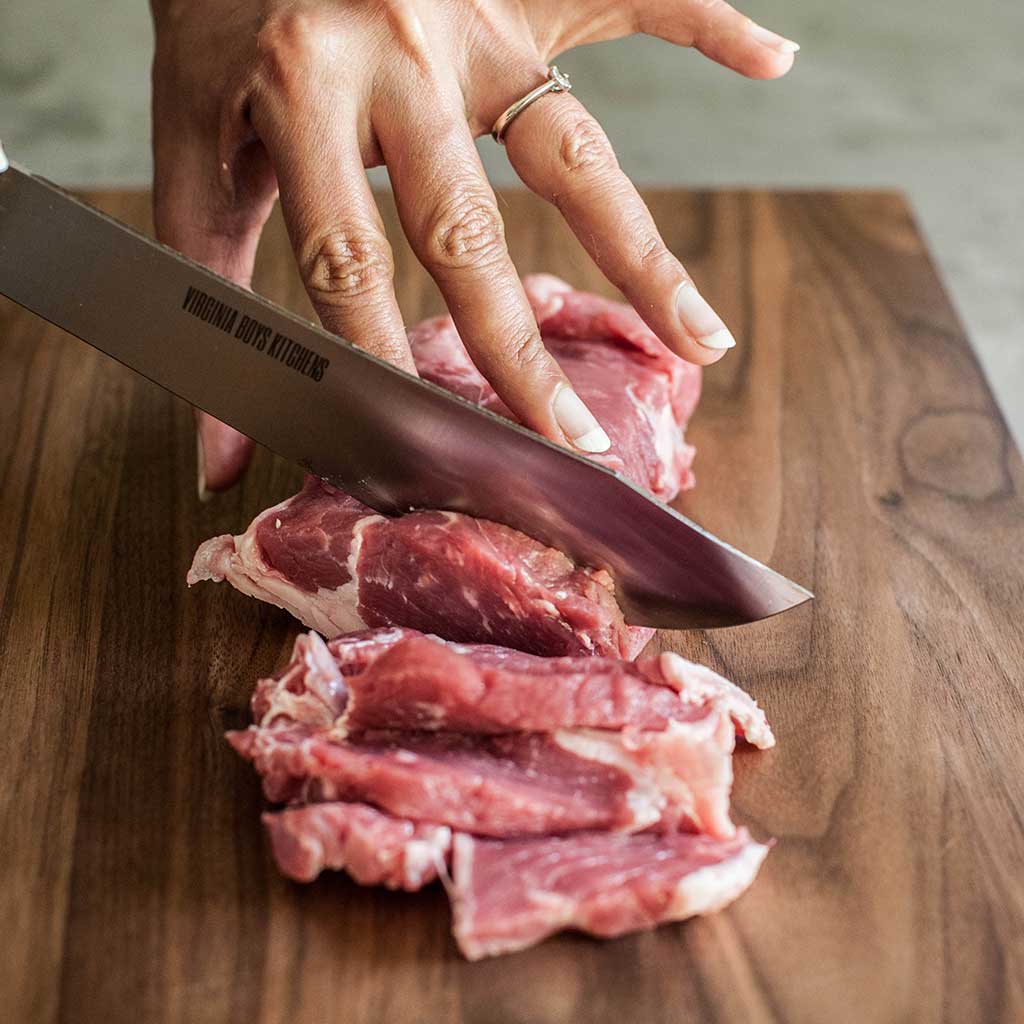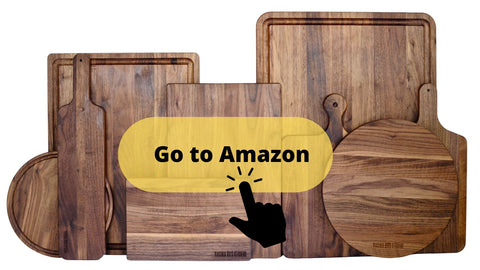If you do a lot of food prep, you might be wondering what type of cutting board is best for handling raw meat. Is plastic okay to use? What about marble, glass, or bamboo? Let's talk about what features you might want to consider when choosing a meat cutting board:
1. Material - must be antimicrobial resistant
2. Juice Groove - to catch raw meat juice when prepping or carving
3. Non Slipping - a sturdy surface is required when handling raw meat
Material
When choosing a meat cutting board, you should look for a material that is both durable and non-porous. You would also want a material that does not easily harbor bacteria when the board has knicks and cut marks on it. You would also want a board made from material that does not slip around on your countertop.
Juice Groove

One common design feature to look out for when selecting a cutting board is a juice groove, which is an indentation on the cutting board that catches excess juices when carving meat to prevent spills.
The juice groove helps to contain the liquids which come off of the meat and prevents them from dripping onto the countertop or table. The groove also helps to keep the board's surface clean and free of excess liquids.
Non Slip Edge
A non slip edge is a great feature but not a necessary feature on cutting boards, especially when used to cut meat. It helps keep the board in place and prevents it from slipping or sliding when pressure is applied.
However for most countertop materials such as granite and quartz, a good wood board will be just fine. You can add rubber feet if you like, or simply use a damp towel underneath.
Larger wood boards tend to be heavy enough to also stay in place when being used. Slim, thin and flimsy plastic boards do not have this advantage.
So, What Material is Best for Meat Cutting Board?

Wood is the best material, here's why
Wood is the best material for a meat cutting board because it's both gentle on knives and more environmentally friendly than plastic.
It's also incredibly durable, with the ability to be sanded and shaved down if it becomes too deeply grooved.
Additionally, wood is an ideal surface for meat preparation because the bacteria that may get into the board die quickly below the surface, keeping it safe and clean.
Finally, wood boards come in a variety of types, such as teak, maple, walnut, and cherry. At Virginia Boys Kitchens, all of our cutting boards are made from walnut wood grown in America, and sustainably harvested. See the full collection here.
There are certain woods that have no business ever being a cutting board such as pine, oak, and cedar - see best wood for cutting board for full article on why this is.
Is it safe to use a plastic cutting board for raw meat?

Using plastic cutting boards for raw meat is not recommended due to the risk of cross-contamination.
Plastic boards can develop persistent stains, deep grooves and deep scratches over time, which can harbor bacteria and make it difficult to clean thoroughly. These bacteria can then transfer to other foods, increasing the risk of foodborne illness.
Additionally, plastic boards are not as durable as other materials, such as bamboo or hardwoods such as walnut, maple, or cherry, and are more prone to damage from knives. This can lead to even more grooves and scratches, further increasing the risk of contamination.
While plastic cutting boards may be convenient and affordable, they are not the best option for cutting raw meat.
What type of cutting board should you not use with raw meat?

Glass, ceramic, and marble cutting boards might be great for cutting cheese or butter, but should not be used for raw meat.
They are not ideal due to their inherent slipperiness. These materials are very smooth and offer little to no traction for the knife, making it difficult to cut through raw meat.
Also, the hard surface of these materials can also cause the blade of your sharp knives to become blunt over time very quickly, and can even damage the knife's edge.
Also meat juices will slip right off and create a bit of a mess - wood and bamboo boards have options for a groove around the edges to prevent this problem.
How do I prevent cross-contamination when using a cutting board for raw meat?

How do I prevent cross-contamination when using a cutting board for raw meat? [Step-by-step instructions]:
- After each use, thoroughly wash the cutting board with hot, soapy water.
- Rinse the cutting board with clean water and air-dry or pat dry with clean paper towels.
- For wooden cutting boards, including bamboo, rub with food-safe board oil (such as this coconut oil board oil) to help them retain their moisture.
- Apply extra protection with a layer of wax after seasoning the board. Make sure you use a wax that is food safe and is meant for use on cutting boards - your furniture wood wax has no business going near your food! Try this coconut oil and beeswax cutting board wax.
- To sanitize the cutting board, prepare a solution with one tablespoon of unscented, liquid chlorine bleach per gallon of water. Flood the surface of the board with the mixture and let it stand for several minutes before rinsing and drying.
Want a set of beautiful wood cutting boards that matches each other, and looks great in your gorgeous kitchen? Check out our full collection of dark walnut wood boards, made 100% in USA.
Pros and Cons of using Wood Cutting Board for Raw Meat
Pros:
Wood cutting boards are easier on knives than plastic or glass, they look better, and they are environmentally more friendly.
Wood cutting boards can be sanded and shaved down when there are too many grooves from knives, and the bacteria in them die within a short time.
Cons:
The disadvantages of a wood cutting board for meat are that they can get too dry or be exposed to excessive heat and burn, should not be soaked or left wet, and should never be put in the dishwasher. When the board is too worn and hard to clean, it needs to be replaced or sanded down.
Overall

Overall, wood is the ideal material for a cutting board to use for your meat cuts. Plastic is ok but should be replaced when grooves start to show, while glass will damage knives in no time.
Wood boards require more care than plastic or glass, but are most aesthetically pleasing and will last longer.
Related Products You Might Like
View our entire collection of dark wood walnut meat cutting boards - there are many shapes and sizes to choose from. Find your perfect meat cutting board.
See Virginia Boys Kitchens On Amazon
We are on Amazon, see our storefront here. Use coupon code VBKBLOG10 for 10% off your entire purchase of any Virginia Boys Kitchens on Amazon. Apply the code at checkout.



